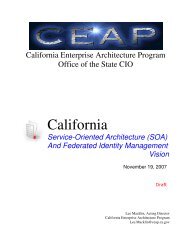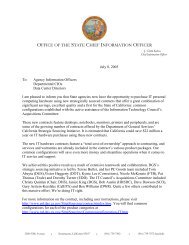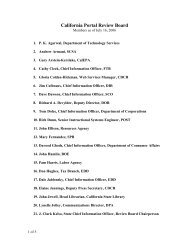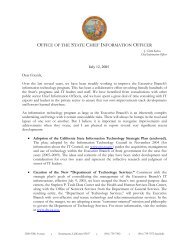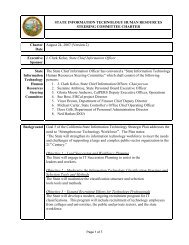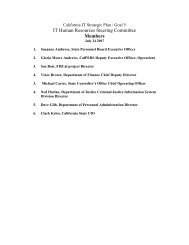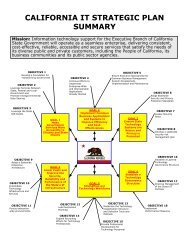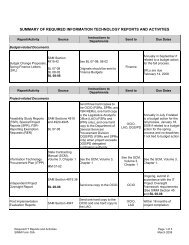Strategic Plan (PDF) - Cioarchives.ca.gov - State of California
Strategic Plan (PDF) - Cioarchives.ca.gov - State of California
Strategic Plan (PDF) - Cioarchives.ca.gov - State of California
Create successful ePaper yourself
Turn your PDF publications into a flip-book with our unique Google optimized e-Paper software.
CALIFORNIA STATE INFORMATION TECHNOLOGY STRATEGIC PLANthe center <strong>of</strong> their own <strong>ca</strong>re. HIT may also reduce dupli<strong>ca</strong>tion, waste, and fraud inhealth<strong>ca</strong>re. Over the next de<strong>ca</strong>de, HIT is expected to revolutionize health<strong>ca</strong>re, makingit more consumer-centric, and improving both the quality and cost-effectiveness <strong>of</strong>health<strong>ca</strong>re in <strong>California</strong>.Actions1. By December 31, 2006, pursuant to Executive Order S-12-06, the Secretaries<strong>of</strong> Health and Human Services Agency and Business, Transportation andHousing Agency, and the <strong>State</strong> CIO, will deliver to the Governor a roadmapfor a health information technology program that improves quality <strong>of</strong> <strong>ca</strong>re,accessibility and affordability for <strong>California</strong>ns.2. By December 31, 2006, the <strong>State</strong> CIO will incorporate the existing CAGovernment Committee on Health Information Technology into the <strong>State</strong>’s IT<strong>gov</strong>ernance structure.Objective 5Support <strong>State</strong>wide Efforts to Expand Broadband Access and Usage in<strong>California</strong><strong>California</strong> is taking action to reduce barriers to broadband access and adoption andadopting measures to ensure that <strong>State</strong> policies evolve in response to ever-changingconditions in the technology marketplace.Pursuant to Executive Order S-21-06, Executive Branch agencies will identify barriers tobroadband access and opportunities for increased broadband adoption. The ExecutiveOrder focuses on strategies that <strong>ca</strong>n be pursued at an administrative level and willeither reduce bottlenecks or build upon “best practices.” An in-depth analysis will alsobe done relating to identifi <strong>ca</strong>tion and resolution <strong>of</strong> <strong>gov</strong>ernment-imposed barriers orobstacles, technology-neutral recommendations for how to achieve statewide ubiquitousbroadband coverage, metrics for evaluating private and public sector efforts, targetsfor region-by-region annual increases in availability and adoption rates, identifi <strong>ca</strong>tion <strong>of</strong>regionally based business broadband deployment models, identifi <strong>ca</strong>tion <strong>of</strong> areas wherestakeholders may aggregate demand for broadband and create opportunities that resultin increased adoption rates, evaluation <strong>of</strong> value-added appli<strong>ca</strong>tions, analysis <strong>of</strong> howpublic and private organizations <strong>ca</strong>n best integrate their efforts, and recommendationsfor how <strong>California</strong> <strong>ca</strong>n better leverage federal, state, and private foundation grant andloan programs relating to broadband. Together, public and private stakeholders willenable continued improvements in health<strong>ca</strong>re, public safety, edu<strong>ca</strong>tion, and the economy.Actions1. By February 27, 2007, the <strong>California</strong> Broadband Task Force will deliver to theGovernor a preliminary report that identifi es administrative actions that <strong>ca</strong>n12



